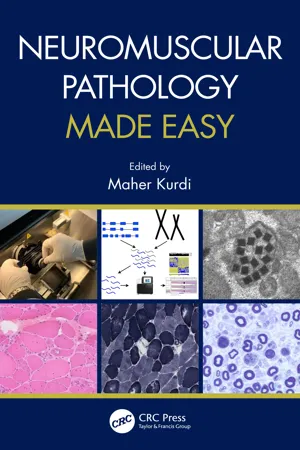
- 240 pages
- English
- ePUB (mobile friendly)
- Available on iOS & Android
Neuromuscular Pathology Made Easy
About This Book
The scope of Neuromuscular Pathology continuous to expand, as evidenced by the numerous multivolume and speciality texts published in recent years. This short textbook provides a complete overview of both clinical and histological aspects of common and rare neuromuscular diseases. The objective is twofold: to provide information about neuromuscular diseases in a simplified, integrated, and rapidly accessible format suited to those initially encountering the discipline, and also to provide a clear approach using simple pictures, tables and algorithms to illustrate histological features in muscle and nerve biopsy.
This volume is conveniently divided into three sections with a total of 30 chapters. The first section deals with basic principles of neuromuscular histology and physiology, processing technique, histochemistry, and laboratory management. The second and third sections deal with neuromuscular diseases that are summarized in a stepwise approach, complemented by algorithms and organized tables.
- A simplified, integrated, and rapidly accessible format covering both common and rare neuromuscular diseases
-
- Clear simple illustrations, organized tables and algorithms to aid the reader in finding an easy approach to accurate diagnosis
-
- Practical tips to facilitate histopathological diagnosis.
-
- Clinical scenarios discussing common neuromuscular conditions
Neurologists, neuropathologists, trainees and medical students involved in clinical neuroscience and pathology will find this guide of practical benefit in both education and practice.
Frequently asked questions
Part I
General
Chapter 1
Muscle and Nerve Histology
1.1Muscle Histology


Protein | Structure | Interaction site |
|---|---|---|
Dystrophin | Sarcolemmal protein with four domains (actin-binding, central rod, carboxyl terminus, cysteine-rich domain) | Sarcoglycan, dystroglycan syntrophin, dystrobrevin |
Sarcoglycan | Transmembrane protein that has four subtypes: α, β, γ, δ | Dystrophin, filamin-C |
Dystroglycan | Transmembrane protein (α, β). α-II laminin (merosin) | Dystrophin, caveolin-3 |
Dysferlin | Type II transmembrane protein | Caveolin-3 |
Caveolin-3 | Protein found in caveolae | Dysferlin, RYR1 |
Myotilin | Sarcomeric Z-disc protein | Filamin-C, α-actinin |
Emerin | Nuclear membrane protein anchored to cytoskeleton | Actin, lamin A/C, CTNNB1 |
Abbreviations: RYR1: ryanodine receptor 1; CTNNB1: catenin beta-1 protein. Note: The interaction site is the binding site where each protein interacts with another one. | ||

Table of contents
- Cover
- Half Title
- Title Page
- Copyright Page
- Contents
- List of Contributors
- Preface
- Acknowledgments
- Abbreviations
- Part I General
- Part II Muscle
- Part III Nerve
- Index